It’s been a while since I’ve photographed a “stiff-tail”. Over two years, to be more precise.
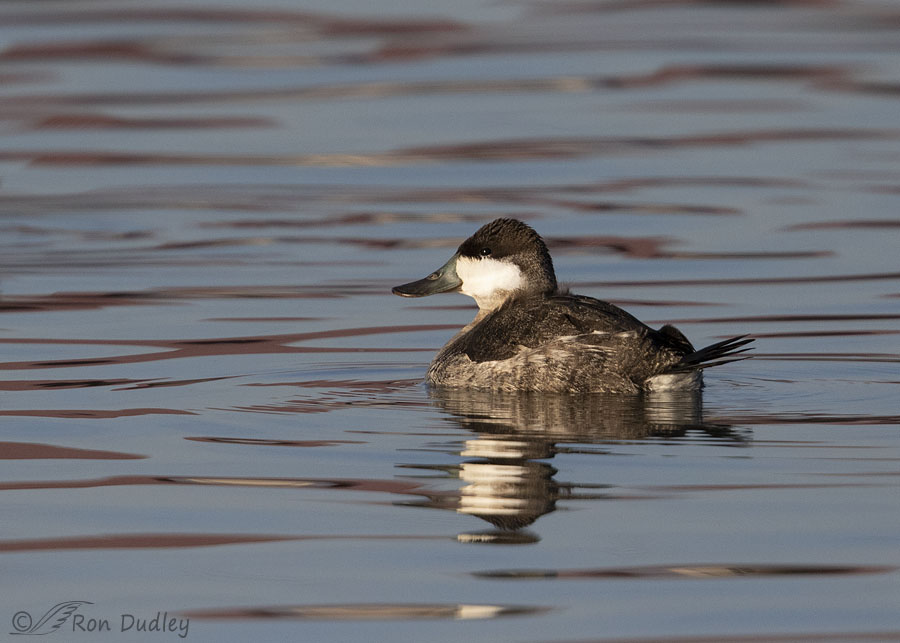
I’ll begin by including this older photo (taken in January of 2022) of a male Ruddy Duck that isn’t in breeding plumage. Comparing this photo to the following photos will demonstrate how transformative their transition to breeding plumage actually is.
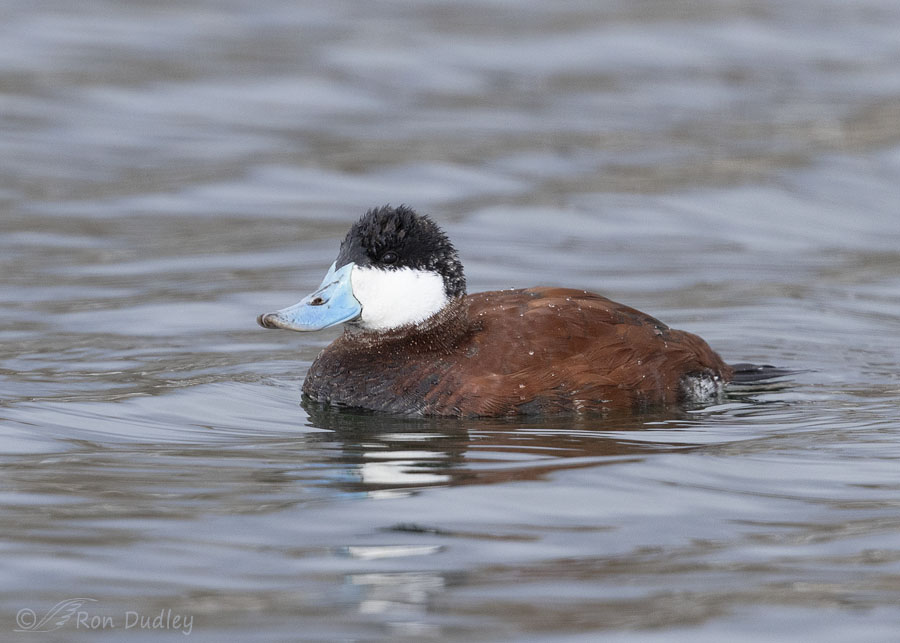
1/2500, f/5.6, ISO 800, Canon R5, Canon EF500mm f/4L IS II USM + 1.4 tc, not baited, set up or called in
I found this drake Ruddy two days ago in some blustery, overcast weather at a local pond. It would be more accurate to say that he found me because I didn’t even know he was there until he swam around the edge of some phrags along the shore right in front of me.
This guy is in full breeding (alternate) plumage, or nearly so. At this stage males have a bright, sky-blue bill, white cheeks, a black cap and nape, a bright reddish-chestnut upper body (including sides and flanks) and a silvery-white belly with darker feather bases showing through. Their dark-brownish tail is often carried in an upright posture and unlike most ducks their wings have no speculum color.
The contrast between the males in the two photos above is so dramatic it might be hard for some to imagine that they’re the same species.
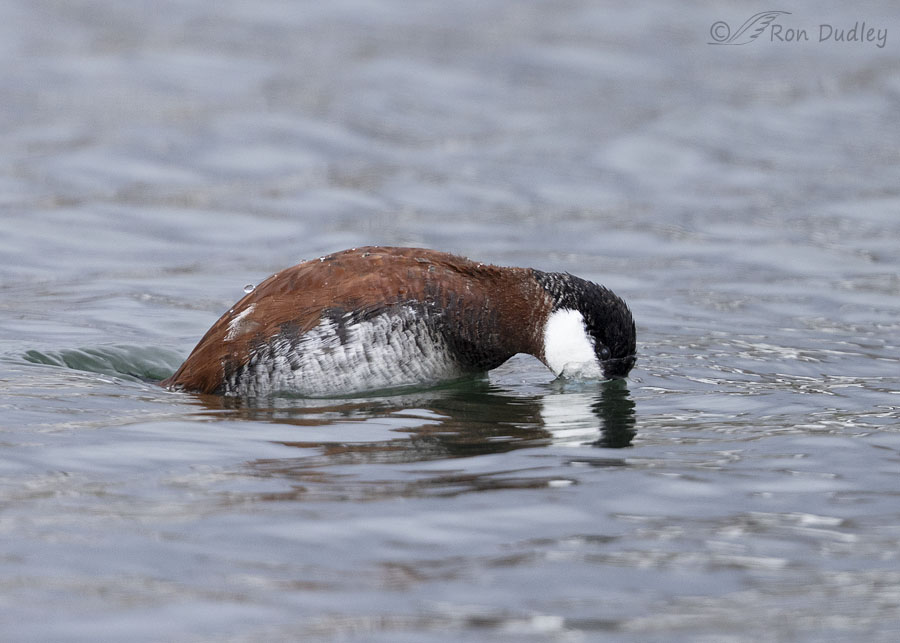
1/2500, f/5.6, ISO 800, Canon R5, Canon EF500mm f/4L IS II USM + 1.4 tc, not baited, set up or called in
While I was with him he spent all of his time diving for food. Or preparing to.
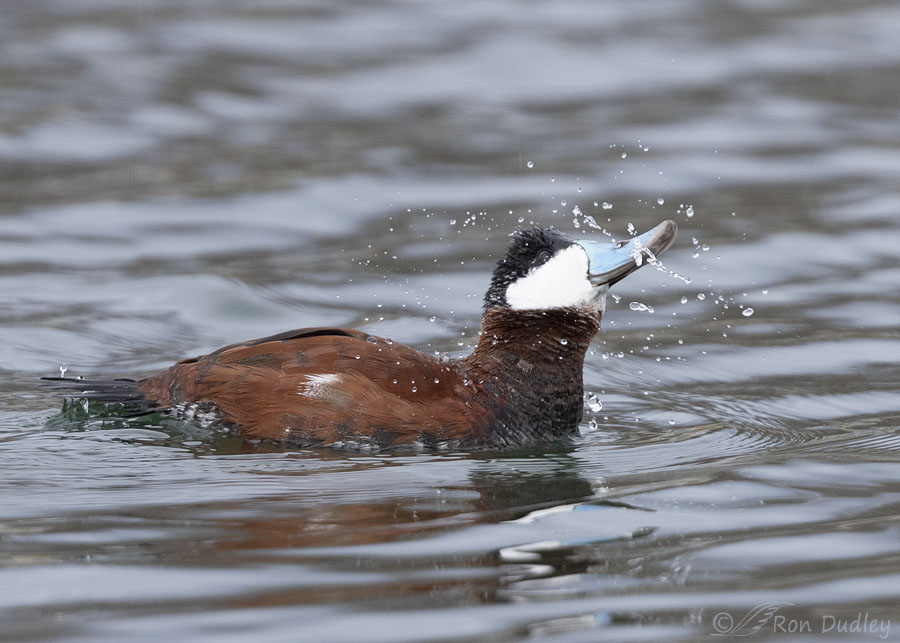
1/2000, f/5.6, ISO 800, Canon R5, Canon EF500mm f/4L IS II USM + 1.4 tc, not baited, set up or called in
After diving, many ducks will rise up in the water and shake their body and/or flap their wings to get rid of excess water but this bird never did that, not once. But after a dive he would reliably shake his head violently, sending water flying. While I was with him he never failed to do so after a dive.
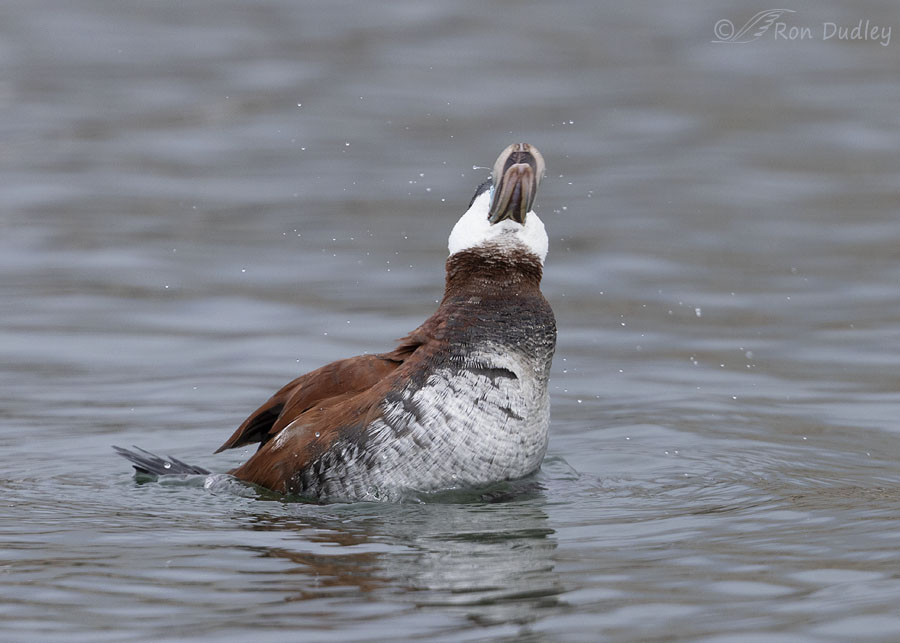
1/2500, f/5.6, ISO 800, Canon R5, Canon EF500mm f/4L IS II USM + 1.4 tc, not baited, set up or called in
He could look pretty silly while doing it. This may not be a flattering pose but it does allow us to see the underside of his bill, which is usually difficult to observe.
It also shows us his light colored belly, which in combination with his darker dorsal surfaces demonstrates “countershading” or Thayer’s Law.
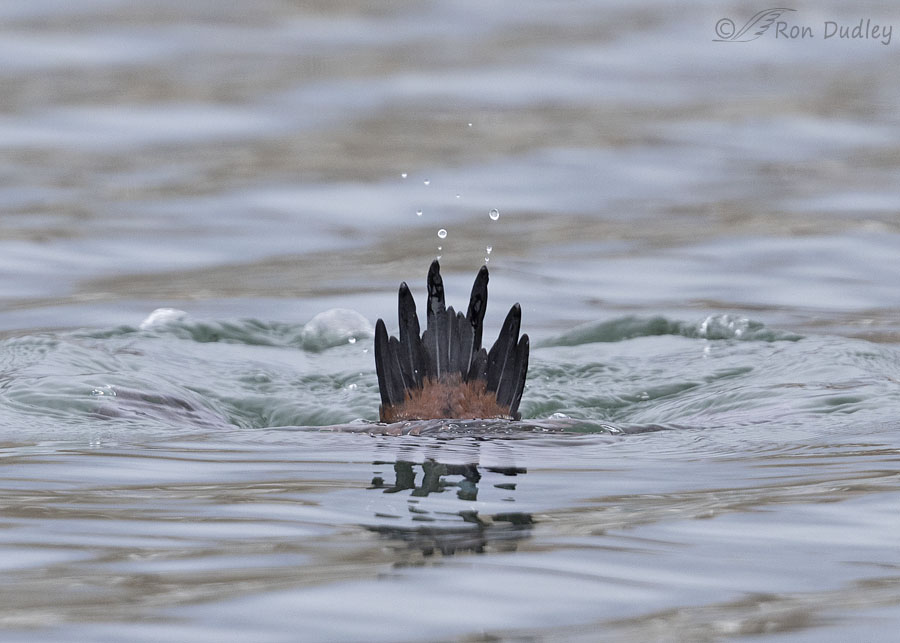
1/2000, f/5.6, ISO 800, Canon R5, Canon EF500mm f/4L IS II USM + 1.4 tc, not baited, set up or called in
Ruddy Ducks are in a genus (Oxyura) of only six species of ducks with long, stiff tail feathers, which are often erected when the bird is resting. All six species are sometimes called “stiff-tails. Since this bird was diving instead of resting, he always kept his tail flat on the water where I couldn’t see it well while he was on the surface.
But when he dived I could clearly see his long (for a duck) stiff tail, as in the photo above. Toward the end of his transition to breeding plumage, he’s still growing his new tail feathers.
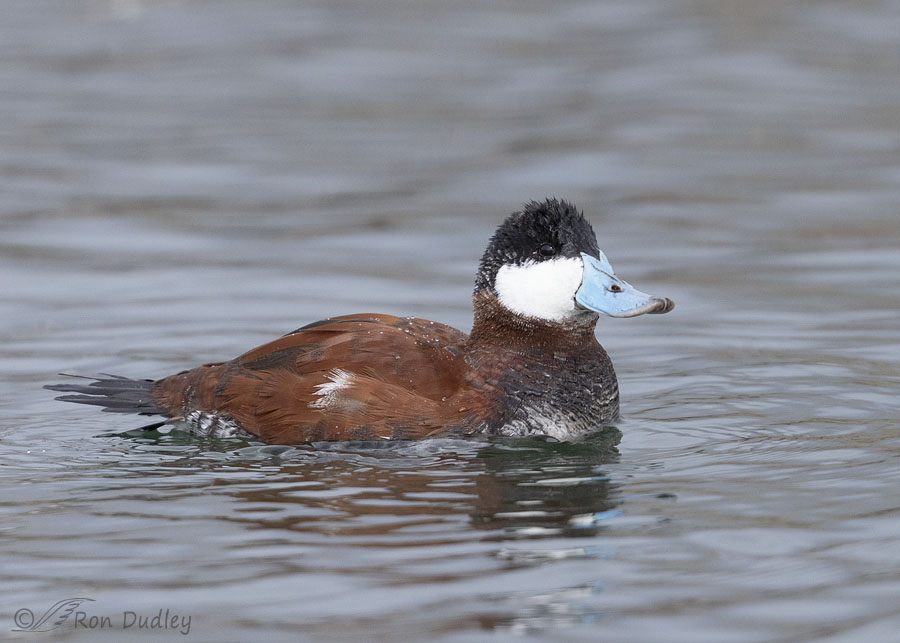
1/2500, f/5.6, ISO 800, Canon R5, Canon EF500mm f/4L IS II USM + 1.4 tc, not baited, set up or called in
The several lighter-colored feathers on his flank appear to be remnants of his previous plumage. As you can see in photo #2, those lighter-colored feathers are missing on his left side.
Until you actually see a Ruddy Duck up close you don’t fully realize how small they are. Ruddy’s are only half the size of a Mallard (1.2 lbs. vs 2.4 lbs.). But the males in breeding plumage really pack a visual punch in a small package. Especially with that striking and highly unusual blue bill that changes color with the season.
Ron


Once he’s in full plumage, he’s going to be very popular with the ladies! 😍 I especially like both the diving shot that features his tail and the movement of the water as well as the shot with the underside of his bill — fascinating (as is Dan’s explanation for the blue bill)!
TIL some ducks can change their bill color. 😀 COOL!
Neat trick, huh Arwen.
Beautiful photos AND learning something new. That’s the stuff I come here for 🙂 Thank Ron.
Good. Thank you, Bill.
That blue bill is always a very striking feature. But as with feathers, there is no blue pigment. I believe that one dove in New Guinea has an unusual blue pigment, but otherwise, blue in birds is structural. Very tiny vacuoles in the keratin reflect blue light, or green in some birds. In the Ruddy Duck, a hormonal change causes a change in the thickness of the sheath covering the keratin of the bill. This change results in blue light being reflected. Chemical analysis shows no pigment is involved.
The Ruddy Duck’s display is also great fun to watch. The male raises his head and repeatedly and rapidly bangs the breast with the underside of the bill. Fun birds. Thanks for sharing.
That’s a fascinating tidbit about the reason for the color of their bill, Dan.
I’ve wanted to photograph their display for a very long time but I’ve only seen hints of it from far away and never been able to photograph it.
Thanks so much for the clip on “countershading”…..I would have
never guessed that its reverse would also have a function ( as in
the skunk’s ).I loved seeing the contrast between breeding and
regular coloration, and enjoyed Carolyn’s reference to fake
fingernails–I KNEW that weird blue bill coloration reminded me of something I’d seen before, and that was it !
You’re very welcome, Kris. I liked that part of Carolyn’s comment too.
Very interesting Ron. We normally have quite a few here. The first time I saw one in the breeding plumage many years back I had no idea what it was. I have never seen the underside of the bill so appreciate seeing that.
Thanks, Everett. We never have very many, at least that I see. And around here they’re pretty shy too.
Neat! That’s REALLY a dramatic change to breeding plumage. I was aware of the countershading and camoflauging benefits in fish – had not thought about it in other creatures even though I’m aware of Canada Geese in flight becoming less visable at times with the lighter breast….. 🙂 Another educational post for me…… 🙂
“Another educational post for me”
Glad to hear that, Judy.
I have a birder friend (April Olson, you know of her) who is visiting the Great Falls area right now. She spent some time at Big Springs yesterday. I hope there are birds at Freezeout.
They say the geese are starting to come in at Freezeout as well as some ducks – not “peak” time but better than last year for her (hopefully)…….glad she’s able to come again……
She always goes up there with a friend this time of year so her friend can attend a big Western art show. I think April is generally more interested in birds but the timing isn’t the best for birds in MT. .
So interesting! The view of the underside of his bill is very weird. And then you go back and look at the other images again – that blue bill is just weird – a fake plastic thing that has been glued onto his normal bill, like badly done fake fingernails 😄.
Some dogs change their nose color, dark to pink, winter to summer. I wonder if it’s the same mechanism.
“a fake plastic thing that has been glued onto his normal bill, like badly done fake fingernails”
Made me smile, Carolyn. I wouldn’t dispute your theory…
Amazing! What a wonderful little duck!
Thanks, Joanne. I agree.
Interesting. A change in plumage color I get. But a change in bill color? Never considered that before. That one I need to look up.
As ever, thought provoking Ron.
” But a change in bill color? Never considered that before.”
Yeah, it’s pretty unusual, isn’t it Michael. I can’t think of another example like it, although I wouldn’t be surprised in the least if there are some. Especially in genus Oxyura.
Another great lesson. Very interesting Ron.
Thank you for sharing it
Thanks very much, Jorge.